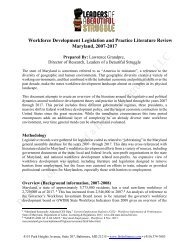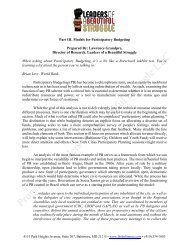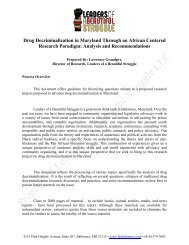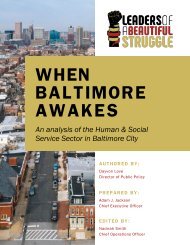The Communal Impacts of Drug Criminalization in Maryland
This project attempts to reframe the harms of drug criminalization. Influenced by African-Centered Research Methodologies, we engaged in a literature review and qualitative research of the communal impacts of drug decriminalization in Maryland, with a specific focus on Baltimore.
This project attempts to reframe the harms of drug criminalization. Influenced by African-Centered Research Methodologies, we engaged in a literature review and qualitative research of the communal impacts of drug decriminalization in Maryland, with a specific focus on Baltimore.
You also want an ePaper? Increase the reach of your titles
YUMPU automatically turns print PDFs into web optimized ePapers that Google loves.
advocates trust the experience <strong>of</strong> other nations that decrim<strong>in</strong>alization didn’t <strong>in</strong>crease drug sales, drug use,<br />
or violent crime, given these nations have fundamentally different histories, demographics, patterns <strong>of</strong><br />
violent crime, and gun laws? Is it surpris<strong>in</strong>g that Black community members don’t quite show trust <strong>in</strong> the<br />
rigor <strong>of</strong> decrim advocate’s analysis <strong>of</strong> White Supremacy?<br />
This is not to say this model is <strong>in</strong>herently bad, but its presentation uncritically as a best practice model for<br />
American policy must be rethought, and the communities have legitimate concerns about these models<br />
which must be met with legitimate answers. Whatever system is presented for decrim, putt<strong>in</strong>g community<br />
control and structure accountability to the community at its center will be key to prevent<strong>in</strong>g decrim from<br />
potentially becom<strong>in</strong>g another vector <strong>of</strong> anti-Black violence.<br />
Places have fundamentally different political histories, needs, and importantly, <strong>in</strong>digenous cultural and<br />
community resources. See<strong>in</strong>g how crim<strong>in</strong>alization prevents these resources from be<strong>in</strong>g cultivated, and<br />
how decrim<strong>in</strong>alization can build community-controlled <strong>in</strong>frastructure that cultivates these resources,<br />
should be central to future research and policy work on decrim.<br />
3. Be Prepared to Negotiate “<strong>The</strong>rmostatic” Crim<strong>in</strong>al Justice Policymak<strong>in</strong>g and Reject the<br />
Violent/Nonviolent Offender Dichotomy<br />
Fordham University pr<strong>of</strong>essor John Pfaff <strong>in</strong> his book, Locked In: <strong>The</strong> True Causes <strong>of</strong> Mass Incarcerationand<br />
How to Achieve Real Reform notes that drug policies have regularly relied on a “standard story” <strong>of</strong><br />
mass <strong>in</strong>carceration, driven by mandatory m<strong>in</strong>imums for nonviolent low-level drug <strong>of</strong>fenses, to push<br />
“pragmatic” drug policy reforms (83). He notes that this standard model no longer corresponds with<br />
reality, writ<strong>in</strong>g:<br />
“In reality, only about 16 percent <strong>of</strong> state prisoners are serv<strong>in</strong>g time on drug charges—and very<br />
few <strong>of</strong> them, perhaps only around 5 or 6 percent <strong>of</strong> that group, are both low level and<br />
nonviolent. At the same time, more than half <strong>of</strong> all people <strong>in</strong> state prisons have been convicted <strong>of</strong><br />
a violent crime. A strategy based on decrim<strong>in</strong>aliz<strong>in</strong>g drugs will thus disappo<strong>in</strong>t—and disappo<strong>in</strong>t<br />
significantly....”<br />
In <strong>Maryland</strong> specifically, Pfaff notes that:<br />
“<strong>Maryland</strong>, generally more liberal than South Carol<strong>in</strong>a, passed a reform bill <strong>in</strong> 2016 that also<br />
cut sanctions for nonviolent crimes while <strong>in</strong>creas<strong>in</strong>g punishments for some violent ones <strong>in</strong> order<br />
to avoid look<strong>in</strong>g ‘s<strong>of</strong>t on crime.’” (ibid).<br />
<strong>The</strong> concern is echoed <strong>in</strong> some grassroot policy advocates, who are concerned not only that the focus on<br />
non-violent drug <strong>of</strong>fenders trades <strong>of</strong>f with the deeper issues <strong>of</strong> the larger anxieties lawmakers <strong>in</strong> the state<br />
have around Black crim<strong>in</strong>ality, specifically <strong>in</strong> Baltimore City, a place over coded with conceptions <strong>of</strong><br />
crim<strong>in</strong>ality <strong>in</strong> the eyes <strong>of</strong> many lawmakers, that cont<strong>in</strong>ues to drive more crim<strong>in</strong>alization policies.<br />
Moreover, there is concern at “thermostatic” effect, where decreas<strong>in</strong>g crim<strong>in</strong>alization on lower-level drug<br />
crimes gets paired with <strong>in</strong>crease crim<strong>in</strong>alization on other fronts. It is possible that drug policy advocates<br />
will be asked by some to support these sorts <strong>of</strong> <strong>in</strong>creased crim<strong>in</strong>alization on violent crime laws as a quidpro-quo<br />
for support on drug decrim<strong>in</strong>alization.<br />
My group, Leaders <strong>of</strong> a Beautiful Struggle, has consistently pushed back aga<strong>in</strong>st Democrat and<br />
Republican supported mandatory m<strong>in</strong>imum/sentenc<strong>in</strong>g enhancement legislation <strong>in</strong> Annapolis. In this<br />
work, we have had to develop our own alternative version <strong>of</strong> the “Standard analysis” <strong>of</strong> mass<br />
<strong>in</strong>carceration, one more compatible with crim<strong>in</strong>al justice reform that <strong>in</strong>cludes sentenc<strong>in</strong>g reform for the<br />
violent <strong>of</strong>fender who actually make up the majority <strong>of</strong> those <strong>in</strong>carcerated <strong>in</strong> state prisons today. I am<br />
present<strong>in</strong>g an abbreviated form <strong>of</strong> this analysis <strong>in</strong> an appendix to help drug policy advocates respond if<br />
they are faced with a request to support <strong>in</strong>creased crim<strong>in</strong>alization <strong>of</strong> “violent crime” <strong>in</strong> exchange for<br />
support for drug decrim<strong>in</strong>alization.<br />
Us<strong>in</strong>g this analysis to push back aga<strong>in</strong>st sentenc<strong>in</strong>g enhancement and mandatory m<strong>in</strong>imums has allowed<br />
us to push non-reformist reforms that we believe help build the social political <strong>in</strong>frastructure needed for<br />
police and prison abolition, while tak<strong>in</strong>g community concerns for public safety serious and concretely<br />
44 <strong>of</strong> 55









